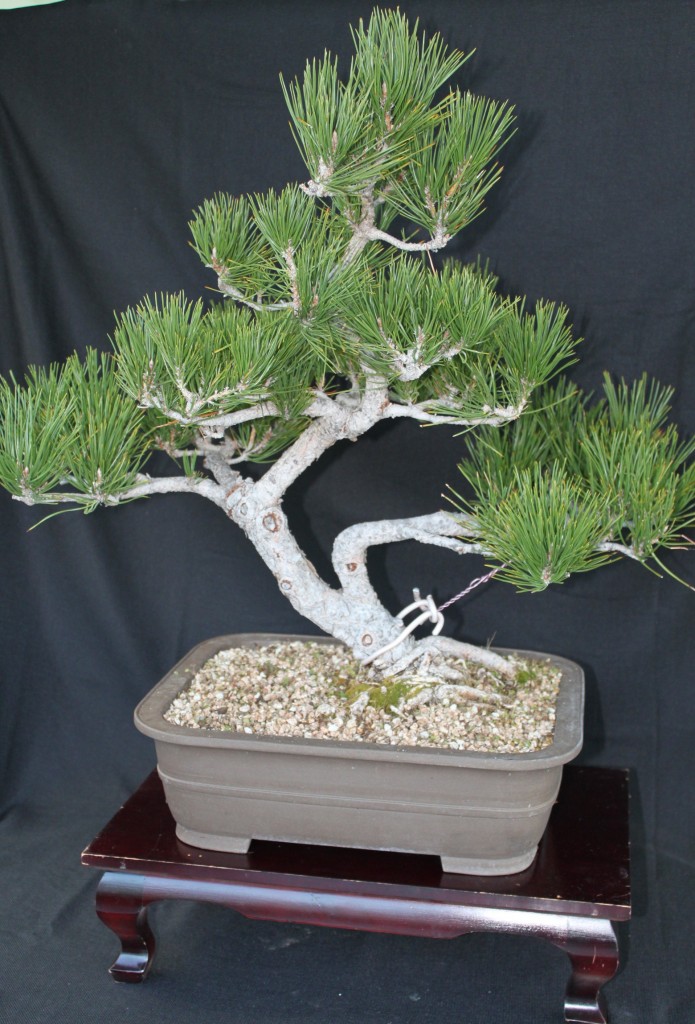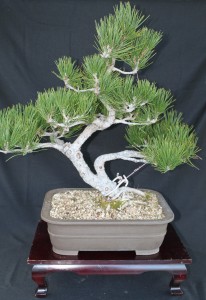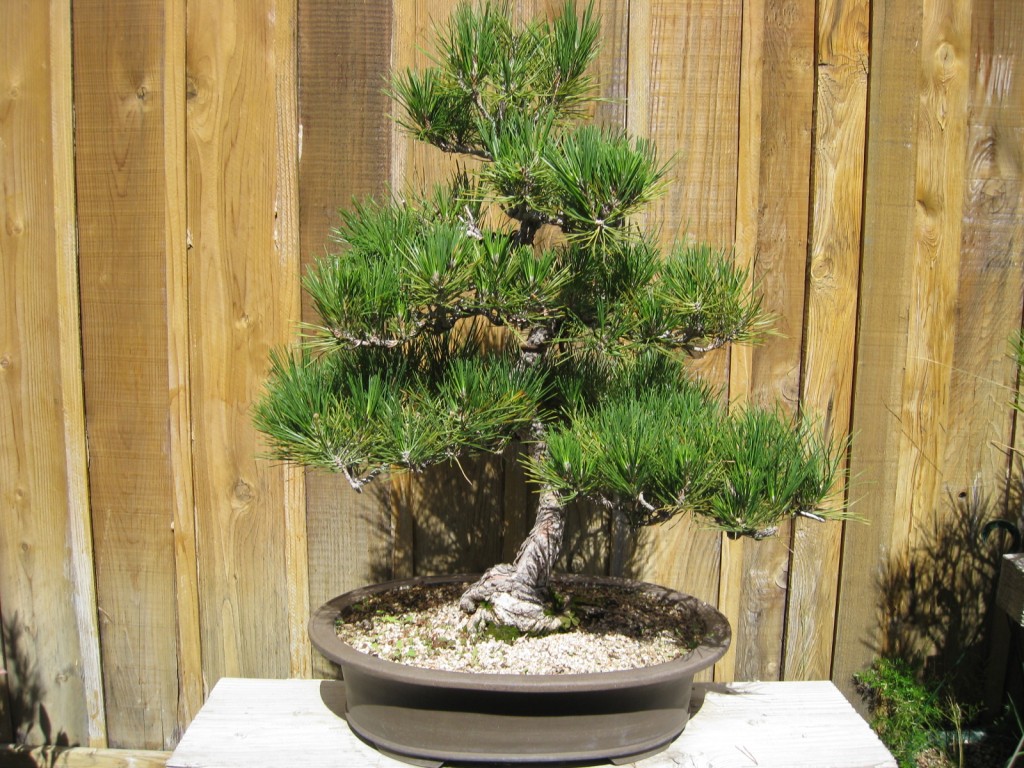Black Pine Bonsai
Black Pine Bonsai
For many folks, the Japanese Black Pine bonsai is the undisputed king. Even people not familiar with bonsai often picture a Black Pine when they think of bonsai. With its bright green needles, craggy bark, and graceful aspect, the Japanese Black Pine bonsai is the perfect image of an aged tree in miniature. Entire books have been written just on Black Pine bonsai. This article is not meant as a comprehensive treatment of the subject tree, but simply as an overview and a guide to further resources.
Background:
The Japanese Black Pine is a smallish member of genus Pinus native to Japan, China, Taiwan and Korea. Mature specimens generally top out at around 40 feet tall; the typical form is a squat pyramid. The Japanese Black Pine has no known industrial uses in the modern world. It is primarily cultivated as an ornamental tree, and is prized as both a garden tree and for bonsai. The Japanese Black Pine is a two needle pine, meaning that the needles grow in pairs from the stems. Like most Pines, the Japanese Black Pine typically buds once a year in the spring, and all of the year’s growth is contained in the current year’s buds. This subject will be covered in more detail in the pruning section.
The Japanese have been cultivating the Japanese Black Pine as a bonsai subject since at least the 17th Century; some specimens in the Japanese Imperial Collection are 400 years old. The first well documented importation of a Japanese Black Pine bonsai into the United States was as part of a collection given to the United States for the Pan Pacific Exposition in 1915; that particular tree is still alive, and still in San Francisco, and currently under the care of Boon Manakativipart. In the 1920’s, Japanese immigrants brought Black Pine bonsais with them to Southern California. Since then, the Japanese Black Pine has been an important part of California culture, both as a bonsai and as a landscape tree.
Where to Get One:
From a nursery. Collecting a specimen is not possible unless you live in Southern California and someone you know wants to remove a smaller one from a landscape – or if you live in Eastern Europe and have opportunities to collect a specimen of the similar and related Austrian Black Pine. If you are going to buy a nursery specimen, be advised that not all nursery pines are created equal. The Japanese have developed several cultivars specifically for bonsai, such as “Arakawa” and “Nishiki.” These are typically only found at dedicated bonsai nurseries. In the United States, the best cultivar for bonsai culture is the “Majestic Beauty” Black Pine, which is only available from Monrovia Nursery. You can find a retailer through their website (here). Unless you are planning to create a shohin bonsai, try to get a five gallon specimen, or larger. Some very nice bonsais have been created from fifteen gallon Black Pine specimens.
You can also grow your own from seeds. Japanese Black Pine seeds are easily purchased online. Japanese Black Pine seeds germinate easily, but damping off (fungus attack to the base of the seedling) is a real problem, to the point that the moment seedlings emerge, they should be dipped in a weak fungicide solution.
What to do With it After You Get It:
Black Pines thicken very slowly in containers. The best way to thicken a Black Pine fast is by planting it in the ground in a prepared growing bed, and running sacrifice branches. Try to preserve as many branches near the base of the trunk as you can, and keep the weeds away. Make sure they get light and air. Run branches from the base to thicken the base, and run a sacrifice branch from the top of the tree to thicken the whole trunk. It is even possible to run sacrifice branches at different levels to create trunk taper. Be careful to lift the tree and change the soil every two to three years, or it may lose the fine roots near the base, making containerizing it difficult.
Potting and Soil:
In Southern California and similar climes, Black Pine bonsai are best root pruned and potted (or repotted) between Christmas and the first week of April. Once a Black Pine starts pushing long candles, it is too late to repot it, and the preferred time to repot a Black Pine is in December and January.
Soil mix should be twenty to twenty-five percent organic, and the rest aggregate. While some bonsai folks may tell you to use entirely inorganic matter for soil, this is a very bad idea with Black Pine bonsai. Japanese Black Pines have a symbiotic mycorrhizal fungus that grows on the roots, and this fungus helps the tree break down the nutrients in the soil. An organic component in the soil is essential to the health of the fungus, and therefore the health of the tree.
Siting and Watering:
Black Pines are outdoor trees. They need four to six hours of direct sunlight per day. Too much or too little sunlight and the tree will get pale and weak. With the soil set up for proper drainage, a Black Pine bonsai should be watered once a day in summer, every other day in spring and fall, and every third day in winter.
Pests and Diseases:
Large trees are currently threatened by the Pinewood Nematode, which is spread by beetles. After the nematode invades the tree, fungus follows, eventually killing the tree. For bonsais not kept near full size Black Pines, pine borers and Pine Tip Moth are threats, as well as a nasty fungus called needle cast. Trees that are weak due to insufficient nutrients in the soil seem to be more vulnerable to needle case, so keep your tree well fertilized. If you do start noticing needle case, use a good systemic fungicide.
Pruning and Shaping:
Japanese Black Pines have strong apical dominance. They tend to send all of their growth to the top of the tree, at the expense of lower branches. For this reason, you will constantly be applying the techniques below to the top of the tree in stronger proportion than to the lower branches.
The most important thing to remember is: Absent unusual circumstances, Japanese Black Pines bud once a year. They typically start to produce new buds in late winter or very early spring. The buds will start to swell in early spring. Then the buds will take on a spiny appearance as the tips of the new needles emerge. After the buds become spiny, then they elongate into growths called “candles.” In Japanese Black Pine Culture, controlling the size of the candles is everything. Long candles lead to long needles and leggy growth. Short candles lead to compact, dense growth. Aside from directly pinching and pruning the candles themselves, there are many ways to attempt to regulate their size before they emerge. All of these involve pruning the tree or removing needles either in late summer, fall, or early spring.
A typical technique involves removing old needles in the fall or early spring, and leaving three to five pairs of needles at the end of each branch tip. New growth then emerges from between the pairs of needles. Do not use this technique on any tree that shows any signs of weakness. This technique is typically used for creation pruning, or to shorten branch tips and force back budding. A gentler technique for mature trees is to remove old needles in the fall, and leave eight to ten pairs of needles at each branch tip, then remove most of the candles in the spring, leaving only the smallest candles or buds.
In terms of candle pruning or removal, where growth needs to be equalized between branch tips, there are two techniques. The first involves cutting the long candles, or twisting them off to equalize their length with the shorter ones. The second is to remove the longest candles entirely, and work with only the shorter ones.
Styling:
Japanese Black Pine is suitable for all styles of bonsai except broom. (Seriously – if you want to do a broom style bonsai with a Pine, go find an Umbrella Pine, since it naturally grows in that style.) Black Pine can be done as a formal upright, and looks good as one, but keeping the trunk straight and maintaining branch spacing takes some effort. The classic style for Japanese Black Pine bonsai is informal upright, but it also works really well as a semicascade. Cascade style can present problems since the Black Pine has strong apical dominance, and keeping the lower part of the tree from getting weak takes constant work.
Multiple trunk styles are possible, if you can find a multiple trunk specimen. These are rare, and most bonsai growers prefer to use the secondary trunks as sacrifice branches. If you have your heart set on a multiple trunk specimen, you may have to grow your own from seed.
Group plantings can be very dramatic, but you should grow your trees for the group from seeds, or purchase them from the same nursery lot, in order to assure consistency in needle length and color.
Closing Remarks:
Japanese Black Pine can take many years to undergo the transformation from nursery plant to bonsai, but the wait is worth it. In the world of bonsai, there is little to match the power and the beauty of an old, well established Japanese Black Pine bonsai.





